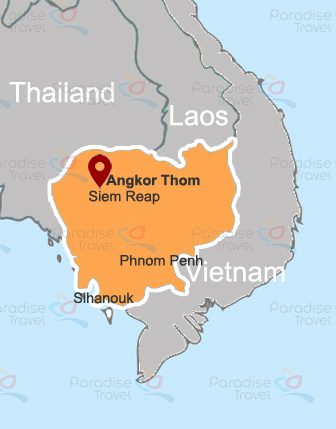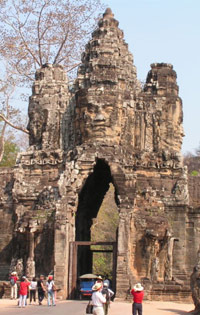Angkor Thom Travel Guide
 Established in the late 12th century by King Jayavarman VII, Angkor Thom Complex was the last flouring capital of the Khmer empire. It is surrounded by a stupendous wall with five entrance gates. The highlights such as the Bayon, the Terrace of Elephants and Terrace of the Leper King are also stunning.
Established in the late 12th century by King Jayavarman VII, Angkor Thom Complex was the last flouring capital of the Khmer empire. It is surrounded by a stupendous wall with five entrance gates. The highlights such as the Bayon, the Terrace of Elephants and Terrace of the Leper King are also stunning.
The Sites
Angkor Thom covers an area of 9 square km, surrounded by a stupendous wall with five entrance gates. The city has five monumental gates, one in the north, west and south walls and two in the east wall. The gates, which are 20 metres in height, are decorated on either side of the passageway with stone elephant trunks and crowned by four gargantuan faces of the bodhisattva Avalokiteshvara. Other than the Bayon, all the main sites are located west or east of the Victory Square. From south to north these are to the west Baphuon, the Terrace of the Elephants, Phimeanakas and the Royal Palace, the Terrace of the Leper King, Tep Pranam and Preah Palilay; to the east, the Prasats Suor Prat, the South Khleang, the North Khleang, and Preah Pithu.
When to go?
The cool dry season is said to be the best time for visits to Cambodia. But for temples exploration, the wet season (from May until Oct) is also a good time as the moats will be full and the foliage lush, though being very soggy.
Travel tips

Touring the temples is a hot and sweaty job, so wear light, airy, covering clothing to protect yourself from the sun and mosquitoes. The sun can be intense so bring a hat, sunglasses and perhaps sunscreen. Consider buying a traditional Khmer scarf (krama) to keep the sun off your neck. Carry a raincoat during the wet season, though you will probably only need it in the afternoon. You should have mosquito repellent for sunrise and sunset hours. Wear practical shoes for climbing narrow steps and walking on uneven surfaces.
